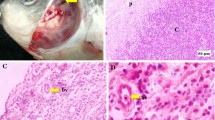Summary
A monoclonal antibody (BM8) raised in the rat against cultured mouse bone marrow-derived macrophages reacted only with macrophages and not with granulocytes, mast cells, platelets, lymphocytes, fibroblasts, and endothelial cells. BM8 did not detect blood monocytes. In cultured bone-marrow cells, expression of BM8-antigen was found on a few macrophages after one day of culture and reached its maximum level with 80% positive macrophages after 7–10 days of culture. The antibody BM8 belonged to the IgG2a subclass, was non-cytotoxic and directed against a 125 kD membrane antigen. In cryostat sections of normal mouse tissues (spleen, lymph node, thymus, liver, skin) BM8 detected tissue-fixed macrophages and Langerhans cells in the skin. In spleen and lymph node, BM8 reacted with macrophages in the red pulp and in the medullary cords, respectively, but not with heavily phagocytosing marginal-zone macrophages, as revealed by in-vivo phagocytosis of colloidal carbon. In granulomata induced by complete Freund's adjuvant, BM8 detected inflammatory macrophages but not epithelioid cells. Thus, antibody BM8 detected a differentiation antigen expressed only on mature, tissue-fixed macrophages.
Similar content being viewed by others
References
Austyn JM, Gordon S (1981) F4/80, a monoclonal antibody directed specifically against the mouse macrophage. Eur J Immunol 11:805–815
Beller DI, Kiely J-M, Unanue ER (1980) Regulation of macrophage populations. I. Preferential induction of Ia-rich peritoneal exudates by immunologic stimuli. J Immunol 124:1426–1432
Brüggen J, Sorg C (1983) Detection of phenotypic differences on human malignant melanoma lines and their variant sublines with monoclonal antibodies. Cancer Immunol Immunother 15:200–205
Cowing C, Schwartz BD, Dickler HB (1978) Macrophage Ia antigens. I. Macrophage populations differ in their expression of Ia antigens. J Immunol 120:378–384
DuBois DB, Rossen RD (1983) Use of human antibodies to identify antigens in cultured human tumor cells: Detection of discrete antigen molecules using electroblotting and enzyme-linked antibody probes. J Immunol Meth 63:7–24
Duijvestijn AM, Hoefsmit ECM (1981) Ultrastructure of the rat thymus: The micro-environment of T-lymphocyte maturation. Cell Tissue Res 218:279–292
Farr AG, Nakane PK (1981) Immunohistochemistry with enzyme labeled antibodies: A brief review. J Immunol Meth 47:129–144
Flotte TJ, Springer TA, Thorbecke GJ (1983) Dendritic cell and macrophage staining by monoclonal antibodies in tissue sections and epidermal sheets. Am J Pathol 111: 112–124
Graham RC Jr, Lundholm U, Karnovsky MJ (1965) Cytochemical demonstration of peroxidase activity with 3-amino-9-ethylcarbazole. J Histochem Cytochem 13:150–152
Hopper KE, Wood PR, Nelson DS (1979) Macrophage heterogeneity. Vox Sang 36:257–274
Hume DA, Robinson AP, MacPherson GG, Gordon S (1983) The mononuclear phagocyte system of the mouse defined by immunohistochemical localization of antigen F4/80. Relationship between macrophages, Langerhans cells, reticular cells, and dendritic cells in lymphoid and hematopoietic organs. J Exp Med 158:1522–1536
Humphrey JH, Grennan D (1981) Different macrophage populations distinguished by means of fluorescent polysaccharides. Recognition and properties of marginal-zone macrophages. Eur J Immunol 11:221–228
Laemmli UK (1970) Cleavage of structural proteins during the assembly of the head of bacteriophage T4. Nature 227:680–685
Lanier LL, Warner NL (1981) Paraformaldehyde fixation of hematopoietic cells for quantitative flow cytometry (FACS) analysis. J Immunol Meth 47:25–30
Lee KC, Berry D (1977) Functional heterogeneity in macrophages activated by Corynebacterium parvum: Characterization of subpopulations with different activities in promoting immune responses and suppressing tumor cells growth. J Immunol 118:1530–1540
Malorny U, Neumann C, Sorg C (1981) Influence of various detachment procedures on the functional state of cultured murine macrophages. Immunobiology 159:327–336
Neumann C, Sorg C (1980) Sequential expression of functions during macrophage differentiation in murine bone marrow liquid cultures. Eur J Immunol 10:834–840
Pulford K, Souhami RL (1981) The surface properties and antigen-presenting function of hepatic non-parenchymal cells. Clin Exp Immunol 46:581–588
Schmalzl F, Braunsteiner H (1968) Cytochemische Darstellung von Esteraseaktivitäten in Blut- und Knochenmarkszellen. Klin Wschr 46:642–650
Silberberg-Sinakin I, Baer RL, Thorbecke GJ (1978) Langerhans cells. A review of their nature with emphasis on their immunologic functions. Progr Allergy 24:268–294
Sorg C, Neumann C (1981) A developmental concept for the heterogeneity of macrophages in response to lymphokines and other signals. Lymphokines 3:85–118
Sun D, Lohmann-Matthes M-L (1982) Functionally different subpopulations of mouse macrophages recognized by monoclonal antibodies. Eur J Immunol 12:134–140
Suter L, Bröcker E-B, Brüggen J, Ruiter DJ, Sorg C (1983) Heterogeneity of primary and metastatic human malignant melanoma as detected with monoclonal antibodies in cryostat sections of biopsies. Cancer Immunol Immunother 16:53–58
Taniyama T, Watanabe T (1982) Establishment of a hybridoma secreting a monoclonal antibody specific for activated tumoricidal macrophages. J Exp Med 156:1286–1291
Towbin H, Staehelin T, Gordon J (1979) Electrophoretic transfer of proteins from polyacrylamide gels to nitrocellulose sheets: Procedure and some applications. Proc Natl Acad Sci 76:4350–4354
Wolff K, Stingl G (1983) The Langerhans cell. J Invest Dermatol 80:17s-21s
Zwadlo G, Bröcker E-B, von Bassewitz D-B, Feige U, Sorg C (1985) A monoclonal antibody to a differentiation antigen present on mature human macrophages and absent from monocytes. J Immunol 134:1487–1492
Author information
Authors and Affiliations
Rights and permissions
About this article
Cite this article
Malorny, U., Michels, E. & Sorg, C. A monoclonal antibody against an antigen present on mouse macrophages and absent from monocytes. Cell Tissue Res. 243, 421–428 (1986). https://doi.org/10.1007/BF00251059
Accepted:
Issue Date:
DOI: https://doi.org/10.1007/BF00251059




